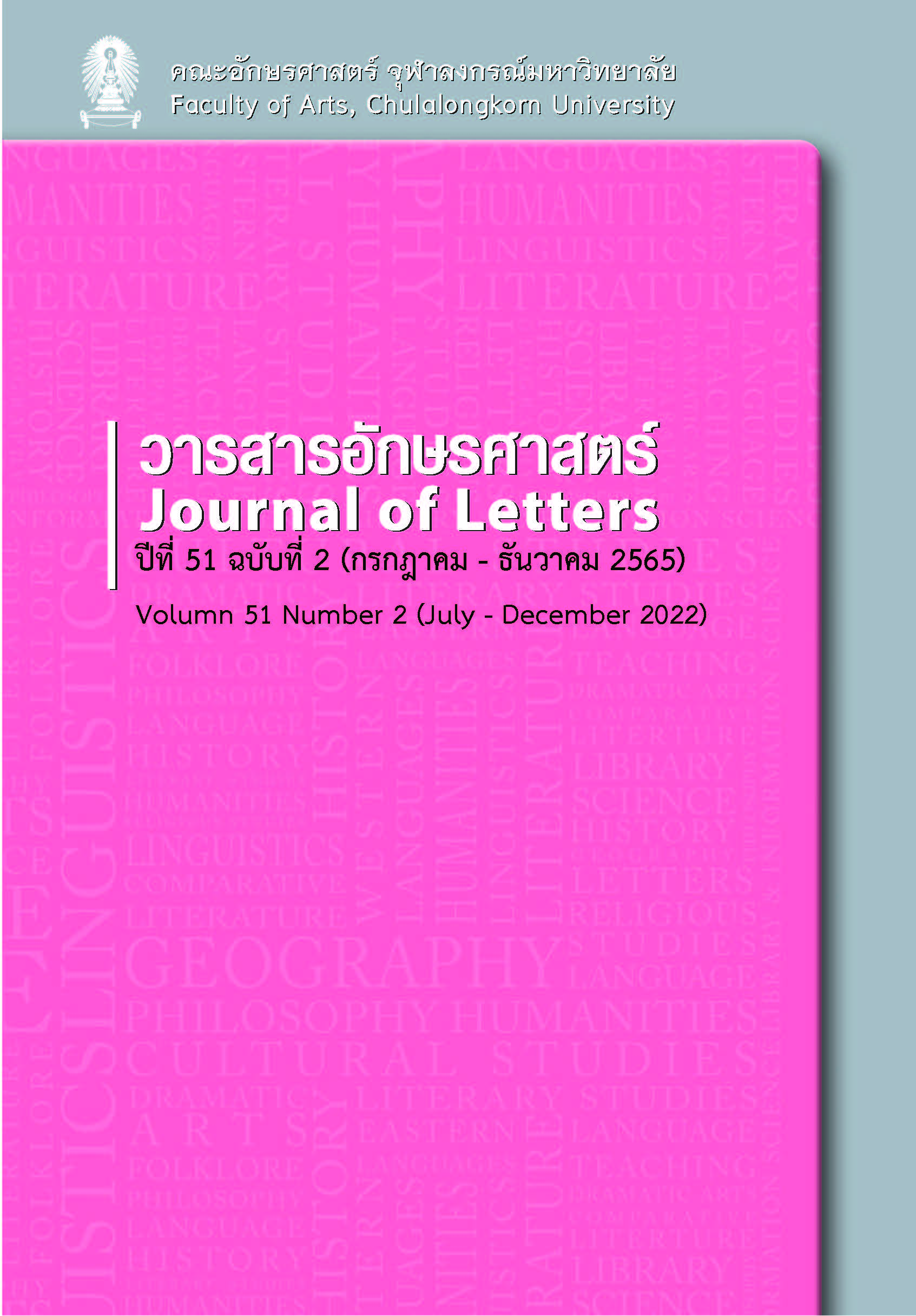English-Thai Conceptual Metaphor Translation in Skincare Advertisements
Keywords:
skincare advertisements, conceptual metaphors, translation, translation strategies, English-ThaiAbstract
This article explores English-to-Thai translations of conceptual metaphors in skincare advertisements on websites. Through a quantitative and qualitative analysis of 120 skincare advertisements and their translations from eight brands collected from their official websites between 2019 and 2021, this study reveals the ten most common conceptual metaphors in skincare advertisements: war metaphors, health metaphors, human-being metaphors, plant and cultivation metaphors, light metaphors, textile and clothing metaphors, machine metaphors, food and nutrition metaphors, cleaning action metaphors, and container metaphors. The most frequent translation strategy found is retention of the source-text conceptual metaphor. Interestingly, addition of a new metaphor into the target text – where there is no metaphor in the original – could be observed, indicating flexibility in advertising translation.
References
ภาษาไทย
Kasikorn Research Center ศูนย์วิจัยกสิกรไทย. (2018). K SME Analysis: Talat beauty young jaew ko trend turakit tham ngoen K SME Analysis: ตลาดบิวตี้ยังแจ๋ว เกาะเทรนด์ธุรกิจทำเงิน [K SME Analysis: Beauty market remains strong, continues to grow. Kasikornbank. Retrieved October 3, 2019, from https://kasikornbank.com/th/business/sme/KSMEKnowledge/article/KSMEAnalysis/Documents/Beauty-Business_Trend.pdf
Nutchanart Uthayansutthi นุชนารถ อุทยานสุทธิ. (2018). Naewtang kanplae kam uppaluk choeng manotat nai tuabot wichakan dan kwamsampan rawang prathet แนวทางการแปลคำอุปลักษณ์เชิงมโนทัศน์ในตัวบทวิชาการด้านความสัมพันธ์ระหว่างประเทศ [A study of conceptual metaphor translation in international relations textbooks] [Unpublished Master’s special research]. Chulalongkorn University.
Pattranooj Saengchantr ภัทรานุจ แสงจันทร์. (2006). Kansueksa nganplae kosana nai suesingpim การศึกษางานแปลโฆษณาในสื่อสิ่งพิมพ์ [A study of advertising translation on printed media] [Unpublished Master’s special research]. Chulalongkorn University.
Ratchanin Pongudom รัชนินท์ พงศ์อุดม. (2005). Kwamsampan rawang phasa gup khaniyom kiaokup kwamngam: Kansueksa watakam kosana krueangsam-ang nai phasa Thai ความสัมพันธ์ระหว่างภาษากับค่านิยมเกี่ยวกับความงาม: การศึกษาวาทกรรมโฆษณาเครื่องสำอางในภาษาไทย [The relationship between language and values on beauty: A study of advertising discourse on cosmetics in Thai] [Master's thesis, Chulalongkorn University]. CUIR. http://cuir.car.chula.ac.th/handle/123456789/64331
Wallapa Jiratikarn วัลลภา จิระติกาล. (2007). Kanchai phasa nomnaochai nai kosana krueangsam-ang samrap phuchai nai nittayasan phuchai pi por sor 2549 การใช้ภาษาโน้มน้าวใจในโฆษณาเครื่องสำอางสำหรับผู้ชายในนิตยสารผู้ชายปีพ.ศ. 2549. [Persuasive devices in Men’s cosmetics advertising in men’s magazines in 2549 B.E.] [Master's thesis, Chulalongkorn University]. CUIR. http://cuir.car.chula.ac.th/handle/123456789/52094
Wattana Chamwong, Kanchana Prayngarm & Piyaphon Paichit วัฒนา แช่มวงษ์, กาญจนา พรายงาม และปิยพล ไพจิตร. (2015). Konlawithi kanchai phasa nai watakam kosana krueangsam-ang nai phasa Thai กลวิธีการใช้ภาษาในวาทกรรมโฆษณาเครื่องสำอางในภาษาไทย [The strategies of using language in cosmetics advertising]. Rajamangala University of Technology Rattanakosin. http://repository.rmutr.ac.th/123456789/469
ภาษาอังกฤษ
Alshunnag, M. B. (2016). Translating conceptual metaphor in popular biomedical texts from English to Arabic [Doctoral dissertation, University of Salford]. University of Salford Institutional Repository. https://usir.salford.ac.uk/id/eprint/39306/1/final%20-%20Copy%20(2).pdf
Bai, Z. (2018). The characteristics of language in cosmetic advertisements. Theory and Practice in Language Studies, 8(7), 841-874. http://dx.doi.org/10.17507/tpls.0807.16
Chen, H., Qiu, R., & Wang, Y. (2013). The translation strategy of advertisement based on nonequivalence between Chinese and English conceptual metaphors. International Journal of English Linguistics, 3(5), 29-37. https://doi.org/10.5539/ijel.v3n5p29
Deignan, A., Gabrys, D., Solska, A. (1997). Teaching English metaphors using cross-linguistic awareness-raising activities. ELT Journal, 51(4), 352-360. https://doi.org/10.1093/elt/51.4.352
Kaur, K., Arumugam, N., & Yunus, N. M. (2013). Beauty product advertisements: A critical discourse analysis. Asian Social Science, 9(3), 61-71. https://doi.org/10.5539/ass.v9n3p61
Kittay, E., & Lehrer, A. (1981). Semantic fields and the structure of metaphor. Studies in Language, 5(1), 31-63. https://doi.org/10.1075/sl.5.1.03kit
Kotler, P., & Keller, K. L. (2012). Marketing management (14th ed.). Prentice Hall.
Kövecses, Z. (2010). Metaphor: A practical introduction (2nd ed.). Oxford University Press.
Lakoff, G., & Johnson, M. (2003). Metaphors we live by. University of Chicago press.
Lê, T. T. D. (2018). A study of conceptual metaphors used in English and Vietnamese cosmetic advertisements [Master’s thesis, University of Danang]. Center for Learning Information Resources and Communication. http://tailieuso.udn.vn/bitstream/TTHL_125/9377/1/LeThiThuyDuong.TT.pdf
Newmark, P. (1981). Approaches to translation. Pergamon Press.
Pragglejaz Group. (2007). MIP: A method for identifying metaphorically used words in discourse.
Metaphor and Symbol, 22(1), 1-39. https://doi.org/10.1080/10926480709336752
Reiss, K. (2000). Translation criticism, the potentials and limitations: categories and criteria for translation quality assessment (E. F. Rhodes, Trans.). St Jerome; American Bible Society. (Original work published 1971)
Ringrow, H. (2016). The language of cosmetics advertising. Palgrave Macmillan.
Sawetsiri, S. (2017). A study of moves, linguistic features, and advertising strategies in women’s and men’s online skincare product advertisements [Master’s thesis, Thammasat University]. Thammasat University Digital Collections. https://digital.library.tu.ac.th/tu_dc/frontend/Info/item/dc:126212
Schäffner, C. (2004). Metaphor and translation: Some implications of a cognitive approach. Journal of Pragmatics, 36(7), 1253-1269. https://doi.org/10.1016/j.pragma.2003.10.012
Toury, G. (1995). Descriptive translation studies and beyond. John Benjamins Publishing.
van den Broeck, R. (1981). The limits of translatability exemplified by metaphor translation. Poetics Today, 2(4), 73-87. https://doi.org/10.2307/1772487
Downloads
Published
How to Cite
Issue
Section
License

This work is licensed under a Creative Commons Attribution-NonCommercial-NoDerivatives 4.0 International License.
Copyright and plagiarism
Authors are responsible for obtaining permission to use copyrighted materials from copyright owners. Authors are responsible for observing requisite copyright law when quoting or reproducing copyrighted materials. Quotations and reproductions of content from other published sources must be accompanied by a reference and all sources should be clearly listed in the references section. Quotations and reproductions of content from external sources without due attribution could be considered a severe infringement of academic conduct and may constitute a legal offence under the Copyright Act of B.E. 2537. Any legal ramifications arising from the infringement of copyright regulations would be the sole responsibility of the author(s).



